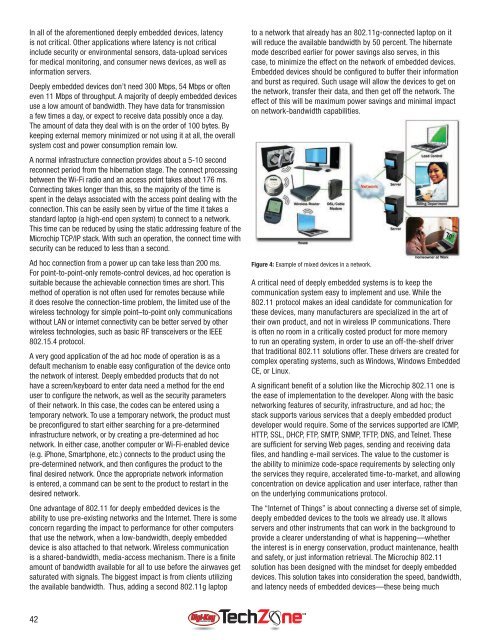Microcontroller Solutions TechZone Magazine, April 2011 - Digikey
Microcontroller Solutions TechZone Magazine, April 2011 - Digikey
Microcontroller Solutions TechZone Magazine, April 2011 - Digikey
You also want an ePaper? Increase the reach of your titles
YUMPU automatically turns print PDFs into web optimized ePapers that Google loves.
In all of the aforementioned deeply embedded devices, latency<br />
is not critical. Other applications where latency is not critical<br />
include security or environmental sensors, data-upload services<br />
for medical monitoring, and consumer news devices, as well as<br />
information servers.<br />
Deeply embedded devices don’t need 300 Mbps, 54 Mbps or often<br />
even 11 Mbps of throughput. A majority of deeply embedded devices<br />
use a low amount of bandwidth. They have data for transmission<br />
a few times a day, or expect to receive data possibly once a day.<br />
The amount of data they deal with is on the order of 100 bytes. By<br />
keeping external memory minimized or not using it at all, the overall<br />
system cost and power consumption remain low.<br />
A normal infrastructure connection provides about a 5-10 second<br />
reconnect period from the hibernation stage. The connect processing<br />
between the Wi-Fi radio and an access point takes about 176 ms.<br />
Connecting takes longer than this, so the majority of the time is<br />
spent in the delays associated with the access point dealing with the<br />
connection. This can be easily seen by virtue of the time it takes a<br />
standard laptop (a high-end open system) to connect to a network.<br />
This time can be reduced by using the static addressing feature of the<br />
Microchip TCP/IP stack. With such an operation, the connect time with<br />
security can be reduced to less than a second.<br />
Ad hoc connection from a power up can take less than 200 ms.<br />
For point-to-point-only remote-control devices, ad hoc operation is<br />
suitable because the achievable connection times are short. This<br />
method of operation is not often used for remotes because while<br />
it does resolve the connection-time problem, the limited use of the<br />
wireless technology for simple point–to-point only communications<br />
without LAN or internet connectivity can be better served by other<br />
wireless technologies, such as basic RF transceivers or the IEEE<br />
802.15.4 protocol.<br />
A very good application of the ad hoc mode of operation is as a<br />
default mechanism to enable easy confi guration of the device onto<br />
the network of interest. Deeply embedded products that do not<br />
have a screen/keyboard to enter data need a method for the end<br />
user to confi gure the network, as well as the security parameters<br />
of their network. In this case, the codes can be entered using a<br />
temporary network. To use a temporary network, the product must<br />
be preconfi gured to start either searching for a pre-determined<br />
infrastructure network, or by creating a pre-determined ad hoc<br />
network. In either case, another computer or Wi-Fi-enabled device<br />
(e.g. iPhone, Smartphone, etc.) connects to the product using the<br />
pre-determined network, and then confi gures the product to the<br />
fi nal desired network. Once the appropriate network information<br />
is entered, a command can be sent to the product to restart in the<br />
desired network.<br />
One advantage of 802.11 for deeply embedded devices is the<br />
ability to use pre-existing networks and the Internet. There is some<br />
concern regarding the impact to performance for other computers<br />
that use the network, when a low-bandwidth, deeply embedded<br />
device is also attached to that network. Wireless communication<br />
is a shared-bandwidth, media-access mechanism. There is a fi nite<br />
amount of bandwidth available for all to use before the airwaves get<br />
saturated with signals. The biggest impact is from clients utilizing<br />
the available bandwidth. Thus, adding a second 802.11g laptop<br />
to a network that already has an 802.11g-connected laptop on it<br />
will reduce the available bandwidth by 50 percent. The hibernate<br />
mode described earlier for power savings also serves, in this<br />
case, to minimize the effect on the network of embedded devices.<br />
Embedded devices should be confi gured to buffer their information<br />
and burst as required. Such usage will allow the devices to get on<br />
the network, transfer their data, and then get off the network. The<br />
effect of this will be maximum power savings and minimal impact<br />
on network-bandwidth capabilities.<br />
Figure 4: Example of mixed devices in a network.<br />
A critical need of deeply embedded systems is to keep the<br />
communication system easy to implement and use. While the<br />
802.11 protocol makes an ideal candidate for communication for<br />
these devices, many manufacturers are specialized in the art of<br />
their own product, and not in wireless IP communications. There<br />
is often no room in a critically costed product for more memory<br />
to run an operating system, in order to use an off-the-shelf driver<br />
that traditional 802.11 solutions offer. These drivers are created for<br />
complex operating systems, such as Windows, Windows Embedded<br />
CE, or Linux.<br />
A signifi cant benefi t of a solution like the Microchip 802.11 one is<br />
the ease of implementation to the developer. Along with the basic<br />
networking features of security, infrastructure, and ad hoc; the<br />
stack supports various services that a deeply embedded product<br />
developer would require. Some of the services supported are ICMP,<br />
HTTP, SSL, DHCP, FTP, SMTP, SNMP, TFTP, DNS, and Telnet. These<br />
are suffi cient for serving Web pages, sending and receiving data<br />
fi les, and handling e-mail services. The value to the customer is<br />
the ability to minimize code-space requirements by selecting only<br />
the services they require, accelerated time-to-market, and allowing<br />
concentration on device application and user interface, rather than<br />
on the underlying communications protocol.<br />
The “Internet of Things” is about connecting a diverse set of simple,<br />
deeply embedded devices to the tools we already use. It allows<br />
servers and other instruments that can work in the background to<br />
provide a clearer understanding of what is happening—whether<br />
the interest is in energy conservation, product maintenance, health<br />
and safety, or just information retrieval. The Microchip 802.11<br />
solution has been designed with the mindset for deeply embedded<br />
devices. This solution takes into consideration the speed, bandwidth,<br />
and latency needs of embedded devices—these being much<br />
42














